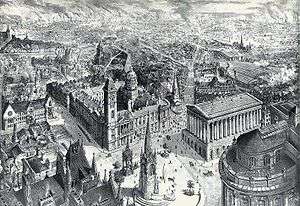Christ Church, Birmingham
Christ Church, Birmingham, was a parish church in the Church of England on Colmore Row, Birmingham from 1805 to 1899.
| Christ Church, Birmingham | |
|---|---|
 Christ Church, now demolished | |
| 52.4798°N 1.9020°W | |
| Location | Birmingham |
| Country | England |
| Denomination | Church of England |
| Architecture | |
| Architect(s) |
|
| Groundbreaking | 1805 |
| Completed | 1813 |
| Construction cost | £26,000 |
| Closed | 1897 |
| Demolished | 1899 |
| Specifications | |
| Length | 140 feet (43 m) |
| Width | 71 feet (22 m) |

History
_retouched_(cropped).jpg)


The church was built by public subscription. The site was donated by William Phillips Ing.[1] The foundation stone was laid on 22 July 1805 by George Legge, 3rd Earl of Dartmouth.[1] The Earl of Dartmouth was representing King George III, who had intended to lay the foundation stone personally, but was prevented from doing so by illness. The King gave £1,000[1] (equivalent to £81,746 in 2019)[2] towards the construction.[3] The final cost was £26,000.[1]
It was consecrated on 6 July 1813 by James Cornwallis, 4th Earl Cornwallis, the Bishop of Lichfield.[1] It was unusual in that all of the seating on the ground floor was free,[1] and it came to be known as the 'Free Church'.
It was built in stone in the Classical style with Doric columns dominating the west front. The square west tower, completed in 1814, supported an octagonal belfry and an octagonal spire. The original design had included a cupola instead of a spire.[4] The catacombs beneath the church were believed to contain the re-interred remains of John Baskerville.[1]
The parish was assigned from St Martin in the Bull Ring and St. Philips' Church in 1865.
The building and site were sold in 1897; the proceeds were used to build St Agatha's Church, Sparkbrook. The church was demolished in 1899. Part of the parish was given to St Barnabas' Church, Birmingham.
Organ
An organ was installed by Thomas Elliot, of London.[5]
References
| Wikimedia Commons has media related to Christ Church, Birmingham. |
- Dent, Robert Kirkup (1894). The Making of Birmingham: Being a History of the Rise and Growth of the Midland Metropolis. David. p. 278+. Retrieved 31 December 2013.
- UK Retail Price Index inflation figures are based on data from Clark, Gregory (2017). "The Annual RPI and Average Earnings for Britain, 1209 to Present (New Series)". MeasuringWorth. Retrieved February 2, 2020.
- An historical and descriptive sketch of Birmingham: with some account of its environs, and forty-four view of the principal public buildings. Beilby, Knott, and Beilby, 1830
- 'Religious History: Churches built since 1800', in A History of the County of Warwick: Volume 7, the City of Birmingham, ed. W B Stephens (London, 1964), pp. 379-396. British History Online http://www.british-history.ac.uk/vch/warks/vol7/pp379-396 [accessed 23 May 2020].
- A Description of Modern Birmingham. Charles Pye. Echo Library, 31 Mar 2007